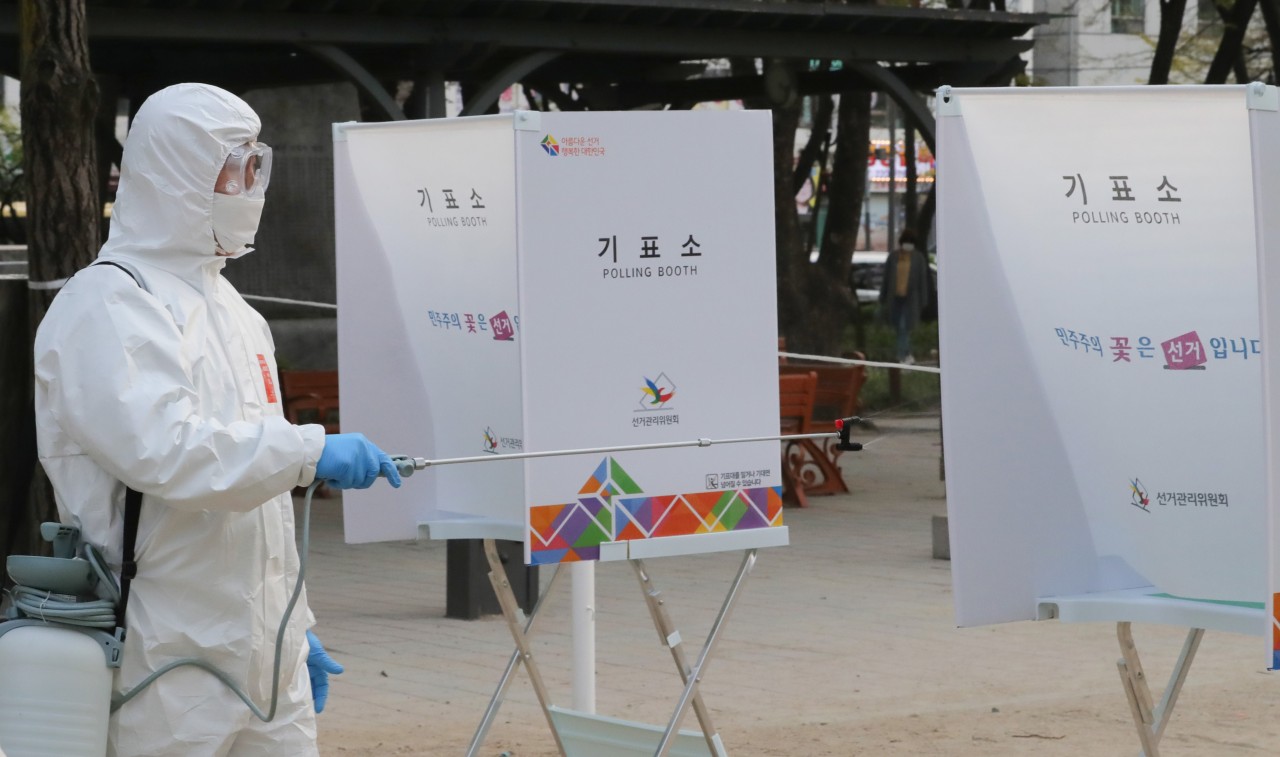Loopholes in quarantine surveillance spark safety concerns
By Kim ArinPublished : April 16, 2020 - 10:21

As the number of people subject to mandatory home quarantine grows, Korean officials are struggling to ensure the orders are being followed. On the day for legislative elections Wednesday, several instances of quarantine breaches were reported, raising safety concerns.
A total of 11,151 out of 59,918 quarantined individuals nationwide had been permitted to vote on Election Day under the condition that they limit their travel to and back from the polling station and wear protective equipment such as a face covering the whole time outside.
To keep the elections infection-free, the Korea Centers for Disease Control and Prevention instituted safety measures such as obligating the use of face masks and single-use gloves and maintaining a distance of 1 meter at polling places. Separate booths were set up for feverish or otherwise symptomatic voters.
The National Election Commission said it spent 22 billion won ($17.9 million) of its budget for virus control, with 158,781 poll workers mobilized for the extra work -- 26,602 more than the last parliamentary election’s workforce of 132,179.
Despite the efforts, at least four self-isolators went astray during the designated hours between 5:20 p.m. and 7 p.m. Wednesday, when they were supposed to vote.
Instead of casting their ballots, some made stops at places like a gaming cafe, pool bar and cellphone store. Several in Songpa, southern Seoul, voted at a regular polling station with other voters.
Officials said they were seeking criminal charges against three of them, including a man in his 50s in Hanam, Gyeonggi Province, who was a second-time offender.
Those who may have come in contact with the quarantine violators have been informed and are undergoing testing.
The latest data shows 58,387 people under quarantine orders as of Thursday. As thousands are quarantined each day, the administrative burden of surveillance is mounting. In Seoul alone, 2,250 officials are charged with monitoring the over 19,000 quarantined residents in the city.
Twenty-two additional people were confirmed with COVID-19 in the preceding 24 hours as of Thursday just after midnight, marking a cumulative total of 10,613 cases.
Of those, 7,757, or 73 percent, have been declared recovered. Two negative results in tests conducted in 24-hour intervals qualifies as a recovery.
But health officials said at least 141 former patients tested positive again after they were deemed cleared of the virus. The disease control agency said it is investigating the “second positive” cases.
The greater Seoul area, including Gyeonggi Province, accounted for the highest proportion of new cases at six. Daegu and North Gyeongsang Province each added four. Busan had three and Gangwon Province one.
The other four were detected at the border. The number of imported cases reached 967.
All arrivals to Korea have been required to self-isolate for 14 days since April 1. In an added screening measure, from Monday, visa waiver programs have been suspended for 90 countries that are banning the entry of Koreans.
Four more people died, bringing the death toll to 229. Korea’s fatality rate stands at over 2 percent. The rate is much higher for those above 80 years old, at 21 percent.
Amid the drop in daily tally, discussions for enabling an economic reopening are underway.
A joint committee for devising “routine distancing” guidance held its second meeting Thursday morning. “Routine distancing” is the term for a renewed virus strategy where social distancing is partially eased to resume economic activity, the committee has explained.
As the second phase of Korea’s “intense” social distancing campaign is set to end Sunday, the committee is conducting a public opinion survey to be reflected in the updated virus plan.
But the committee said lessons from Singapore showed lifting distancing measures could lead to a second wave of the disease, adding, the decision to shift to a scaled-down control strategy would be announced in about one to two weeks.
Seoul National University’s public health research team found 65 percent of its 1,000 respondents in an April 10-13 survey believed risk of transmission will increase once social distancing ceases.
The proportion of people concerned with lax social distancing was highest among those in their 20s at 71 percent, followed by 40-somethings at 68 percent and 30-somethings at 65 percent.
Close to half -- 44 percent -- said Korea was not safe from COVID-19 infections, as opposed to 21 percent who said it was.
Health officials yet again urged people to stay home as much as possible, referring to a recent case in Yecheon, North Gyeongsang Province, where an infected patient was found to have passed the virus on to at least 30 others.
Vice Health Minister Kim Gang-lip said in a Thursday press briefing that the Yecheon case was an example of a social distancing breach leading to mass infections.
“One person, oblivious of infection, failed to practice social distancing and infected some 30 family members, neighbors,” he said. “I hope this serves as an example of how lapses in social distancing can endanger those around.”
By Kim Arin (arin@heraldcorp.com)









![[Today’s K-pop] BTS pop-up event to come to Seoul](http://res.heraldm.com/phpwas/restmb_idxmake.php?idx=644&simg=/content/image/2024/04/17/20240417050734_0.jpg&u=)
![[Graphic News] More Koreans say they plan long-distance trips this year](http://res.heraldm.com/phpwas/restmb_idxmake.php?idx=644&simg=/content/image/2024/04/17/20240417050828_0.gif&u=)
![[KH Explains] Hyundai's full hybrid edge to pay off amid slow transition to pure EVs](http://res.heraldm.com/phpwas/restmb_idxmake.php?idx=644&simg=/content/image/2024/04/18/20240418050645_0.jpg&u=20240419100350)






![[KH Explains] Hyundai's full hybrid edge to pay off amid slow transition to pure EVs](http://res.heraldm.com/phpwas/restmb_idxmake.php?idx=652&simg=/content/image/2024/04/18/20240418050645_0.jpg&u=20240419100350)

